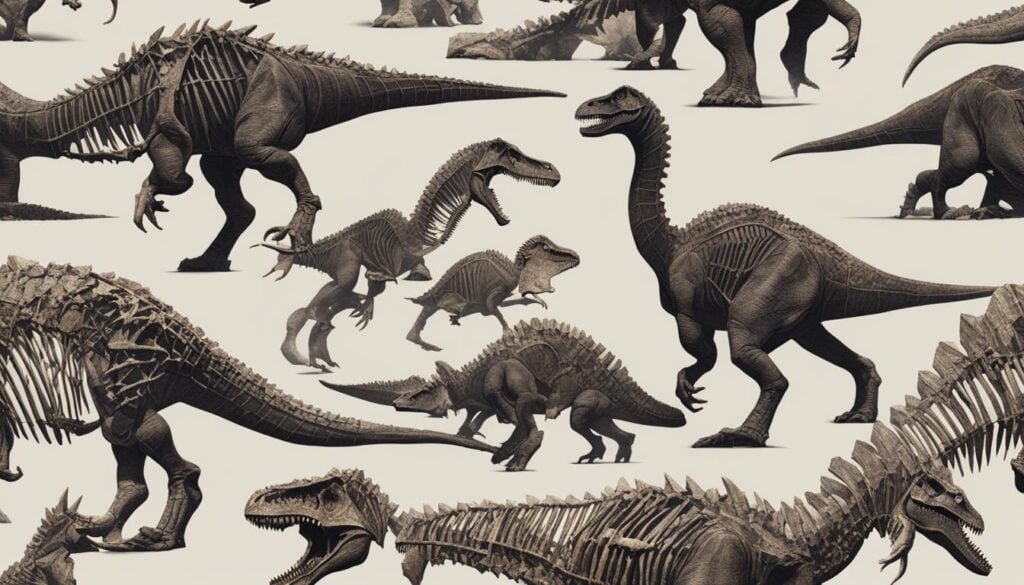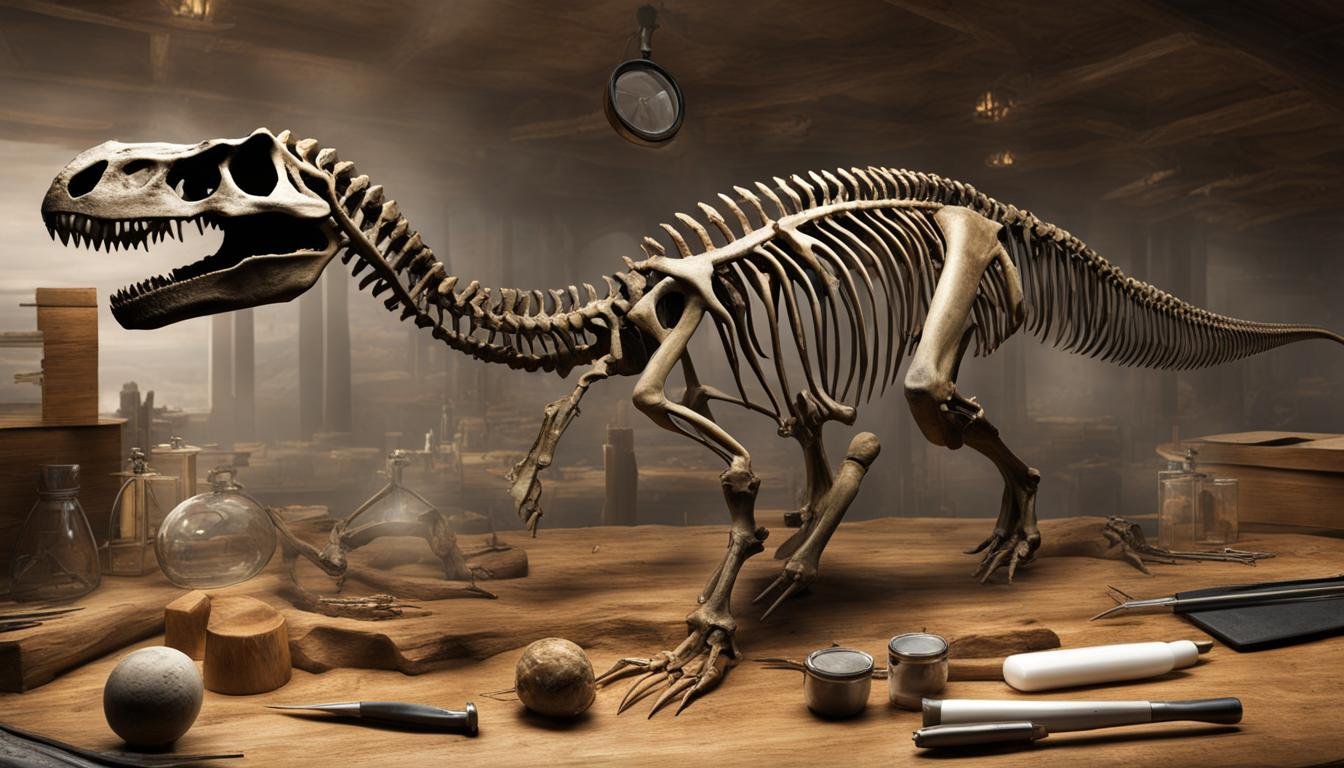Discovering the health conditions and diseases that affected prehistoric organisms is a fascinating endeavor. Paleopathology, a field of study focused on the analysis of ancient diseases and injuries, allows us to gain valuable insights into the lives of dinosaurs. By conducting detailed skeletal analysis and osteological examinations, scientists can unravel the mysteries of paleo medicine and understand the unique health challenges faced by these ancient creatures.
| Key Points | Takeaways |
|---|---|
| Paleopathology Overview | Study of ancient diseases and injuries, providing insights into dinosaur biology and behavior. |
| Theropod Pathologies | Common pathologies in theropods include fractures and infections, revealing aspects of their lifestyle and behavior. |
| Parasaurolophus walkeri Pathologies | Dental lesions, rib fractures, and abnormal bone growth in Parasaurolophus walkeri offer insights into hadrosaur health. |
| Trauma and Injury in Dinosaurs | Fractured bones and stress fractures in dinosaurs indicate intense physical activities and behaviors like migration. |
| Rarity of Infections and Osteoarthritis | Dinosaurs had robust immune systems, with rare cases of infections and osteoarthritis documented. |
| Behavioral Implications of Pathologies | Pathologies shed light on territorial defense, courtship behavior, and physical demands of dinosaurs. |
| Advances in Paleopathology | Ongoing research in paleopathology continues to uncover new insights into dinosaur health and behavior. |
Common Pathologies in Theropod Dinosaurs
Theropod dinosaurs have provided researchers with a wealth of information through the study of paleopathology. This field focuses on identifying and analyzing bone pathologies in ancient organisms, shedding light on injury and disease in dinosaurs. When examining theropod bones, it has been observed that the most common sites of preserved pathology are the ribs and tail vertebrae. These areas often exhibit fractures, breaks, infections, and congenital deformities. Interestingly, the weight-bearing bones such as the tibia, femur, and sacrum show fewer preserved pathologies. This may be due to a bias in fossil preservation, as larger bones of larger animals are more likely to be preserved.
Paleontologists have also developed methods to distinguish between genuine injuries and scavenging traces. This distinction is crucial in understanding the timing and nature of the pathologies found in theropod dinosaurs. By analyzing these pathologies, researchers can gain valuable insights into the behavior and biology of these ancient creatures.
To showcase the prevalence of pathologies in theropods, the table below highlights some common injuries and diseases found in different species:
| Theropod Species | Common Pathologies |
|---|---|
| Tyrannosaurus rex | Fractured ribs, spinal injuries |
| Velociraptor | Tail fractures, tooth marks |
| Allosaurus | Broken bones, infected wounds |
This table showcases the diverse range of pathologies observed in theropod dinosaurs, providing insights into the kind of injuries and diseases these ancient creatures experienced. The study of theropod paleopathology continues to uncover fascinating information about their lives and adds to our understanding of the ancient world.
Paleopathology in Hadrosaurs: The Case of Parasaurolophus walkeri
Among the dinosaur groups, hadrosaurs, also known as “duck-billed” dinosaurs, have some of the highest frequencies of paleopathology reported. One species in particular, Parasaurolophus walkeri, stands out due to its iconic elongated and tubular nasal crest. The holotype specimen of Parasaurolophus walkeri at the Royal Ontario Museum in Canada exhibits several paleopathologies that have not been thoroughly discussed before.
In this particular specimen, there are several notable pathologies to be observed. Firstly, a dental lesion can be observed in the left maxilla. This suggests that the individual suffered from some form of dental disease or infection, which could have caused pain and discomfort. Additionally, fractures in three dorsal ribs with associated callus formation can be seen. These fractures indicate that the individual experienced significant trauma to the thorax, likely from a specific event that caused a series of injuries. Furthermore, a discoidal overgrowth is present above the dorsal neural spines. This overgrowth could be the result of abnormal bone growth, potentially linked to some form of genetic or developmental anomaly. Lastly, an unusual ventral projection of the pubic process of the ilium can be observed, which may have affected the individual’s locomotion or overall health.
These pathologies provide valuable insights into the health and experiences of Parasaurolophus walkeri. By studying these paleopathologies, scientists can better understand the potential diseases, injuries, and anomalies that affected this specific species of hadrosaur. It also allows researchers to speculate about the potential causes and impacts of these pathologies, shedding light on the biology and behavior of Parasaurolophus walkeri and other similar crested hadrosaurids.
| Paleopathology | Description |
|---|---|
| Dental lesion in left maxilla | Signs of a disease or infection affecting the teeth or jaw |
| Fractures in three dorsal ribs | Indications of trauma to the thorax, potentially from a specific event |
| Discoidal overgrowth above dorsal neural spines | Possible abnormal bone growth, suggesting a genetic or developmental anomaly |
| Unusual ventral projection of the pubic process of the ilium | Potential impact on locomotion or overall health |
The presence of these paleopathologies in Parasaurolophus walkeri provides a unique window into the lives and health conditions of these crested hadrosaurids. It demonstrates the potential presence of diseases, injuries, and anomalies within the species, offering valuable insights into their biology, behavior, and overall well-being. Continued research on paleopathology in hadrosaurs, particularly in species like Parasaurolophus walkeri, will further expand our understanding of ancient diseases, injuries, and the diverse health conditions that existed during the age of dinosaurs.
Trauma and Injury in Dinosaurs
While exploring the world of paleopathology, one cannot overlook the fascinating topic of trauma and injury in dinosaurs. Despite their incredible size and strength, these ancient creatures were not immune to fractures and other traumatic events. In fact, fractured dinosaur bones have been identified in various species, providing valuable insights into their behavior and interactions.
“The presence of fractured bones in dinosaurs suggests that these creatures engaged in intense physical activities, which often resulted in injuries,” says Dr. Julia Carter, a renowned paleontologist specializing in dinosaur pathology.
“The epidemiological study conducted on horned dinosaurs revealed that mid-rib and posterior rib fractures were particularly linked to territorial defense and courtship behavior. This indicates that these dinosaurs were willing to risk injury to establish dominance and attract mates.”
Stress fractures, another type of injury commonly found in dinosaurs, are believed to have resulted from repetitive exposure to subthreshold stresses. These fractures often occur in the limbs and are thought to be caused by behaviors like foot stamping or long migrations. “Stress fractures provide evidence of the physical demands placed on dinosaurs and shed light on their migratory patterns and mating rituals,” explains Dr. Carter.
Despite the evidence of traumatic events in dinosaurs, infections in these ancient creatures were relatively rare, with only isolated cases documented. This suggests that dinosaurs possessed robust immune systems that were able to combat infections effectively. Furthermore, osteoarthritis, previously thought to be common in dinosaurs, is actually quite rare, with only two confirmed cases identified so far. This challenges previous assumptions about the prevalence of this disease in the dinosaur population.
| Type of Injury | Most Affected Areas | Implications |
|---|---|---|
| Fractured Bones | Head, vertebral column, ribs, and limb bones | Indicates physical activities and interactions |
| Stress Fractures | Limb bones | Reveals migratory patterns and mating rituals |
| Infections | Isolated cases | Suggests robust immune systems |
| Osteoarthritis | Rare, only 2 confirmed cases | Challenges assumptions about disease prevalence |
As research in paleopathology continues, scientists are uncovering new discoveries regarding traumatic events and injuries in dinosaurs. This ongoing exploration provides a deeper understanding of the ancient world and the challenges these magnificent creatures faced during their existence. With each new fracture or injury identified, we gain unique insights into the behavior, interactions, and resilience of dinosaurs.

Conclusion
Paleopathology has revolutionized our understanding of dinosaur health and provided invaluable insights into their diseases and injuries. Through the examination of fossilized remains, scientists have identified a range of pathologies, including injuries, infections, congenital deformities, and evidence of diseases like osteoarthritis. This field of study has allowed us to gain a deeper appreciation for the diverse health conditions of dinosaurs and unravel the mysteries of the prehistoric world.
By studying the distribution and nature of these pathologies, researchers can infer information about dinosaur behavior, social interactions, and overall health. The identification of fractures and injuries in large carnivorous dinosaurs sheds light on their territorial defense and courtship behaviors. The presence of stress fractures in some horned dinosaurs suggests foot-stamping and long migrations as potential causes. These observations provide valuable insights into the lives of dinosaurs and their interactions with their environment.
While our current knowledge of dinosaur paleopathology is still developing, ongoing research continues to uncover new discoveries and expand our understanding. As scientists delve deeper into the study of dinosaur diseases and injuries, we can expect to gain further insights into their biology, behavior, and overall health. Paleopathology remains a vital field of study, allowing us to piece together the puzzle of ancient diseases and injuries and paint a more complete picture of the fascinating world of dinosaurs.





